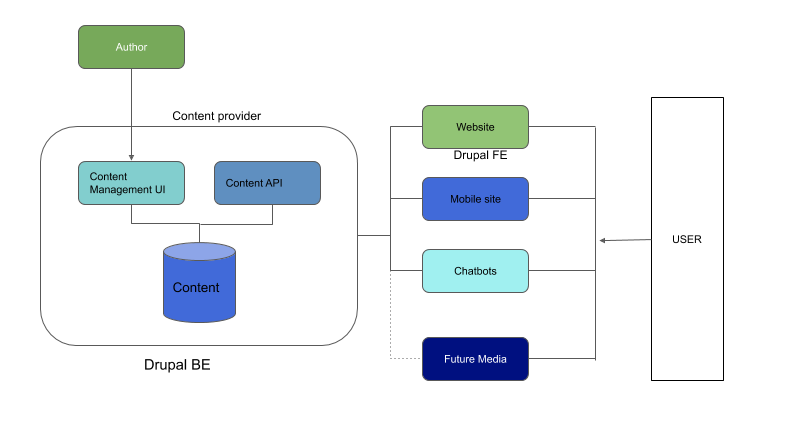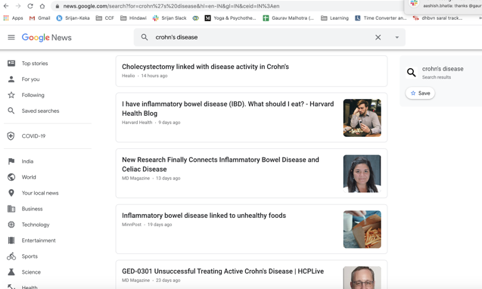Content editing is a major part of any CMS. With the massive explosion of customer touch points, managing content is actually a bigger challenge than creating it. Many Enterprise CMS are powerful, but at the same time complex to use. Editors often need a comprehensive training to learn how to maintain content.
This article introduces content as a service (CaaS) as a way to think about content management that will help website owners and organisations in faster decision making around its usages.
What is Content as a Service?
The traditional CMS has the frontend and backend coupled together and has the simplest general functionality. This structure lacks an API that can manage the communication between these. With Content as a Service, content is centralized into a single repository, where you can manage it, categorize it, make it available to other tools, search for it, or do whatever you wish with it. The data is generally stored in the centralised location over a cloud or on premises and it is then pushed to multiple channels with the help of APIs or similar feeder services. This very differentiation of content from the platform is the basics of Content as a Service.
What does Bloomreach speaks about CaaS
Content as a Service differs from traditional CMS in how content is managed, stored and delivered.
It allows content to be created and stored within the CMS, and then channeled to any platform via APIs and it is up to the developer to create and develop the “presentation tier”. This presentation tier might be a website, a mobile app, or a feed into a device’s interface.
When your company is dealing with multiple sources of content daily, having to manage them all independently requires extra resources, added overhead and a waste of time. Now copying the same content manually on other platforms (or social) is also a tedious task.
However, this cannot be let slip as this can cause an obstruction in the content flow between you and the audience. The idea is to think beyond screens where your audience might interact with the content. This also plays a major role defining a consistent brand message across all platforms. This also triggers the users to play a bigger role and establishes a more refined form of feedback system.
Understanding the Key Use cases of CaaS
- Native mobile apps (or other omni-channels) or a PWA powered by common CMS. However, PWAs can also be done by using drupal frontend only.
- Other apps or social platforms dedicated to a specific category or type of content e.g., medium for blogs or articles, Google news/events for News & events type of content. Here, both of the types are available in CCF site which can be further exposed to similar platforms.
- In addition to providing different ways of presenting content and reaching other media, marketing platforms can analyze content to understand different things using machine learning and NLP.
 Some examples and use cases where CaaS would be useful:
Some examples and use cases where CaaS would be useful:
Any CMS content like news, events, blogs, journals etc., can be published/fed to the following but not limited to:
- Google news
- Google publisher
- Medium (and other blogging sites)
- Facebook pages
- Apple News
- Feeds for readers

How can Srijan help its Clients
Srijan’s team of business analysts, tech architects, and developers can collaborate with you and help in identifying the most appropriate content pieces to be exposed as services for maximum outreach. Our approach is to be as lean and efficient with maximum impact.
We recommend using Drupal as backend/CMS which gives some out-of-the-box modules for feeds, which we can easily extend to give more rich features and capabilities such as auto-update, content massaging and permissions to show or hide content as applicable.
We helped a data insights provider which empowers its clients with intelligent and actionable insights related to agriculture, energy, weather, locations, etc., publishes its updates on google and apple news.
- Primary Image
- Sub head-on or underneath the image
- Byline (Author Information)
- Section information
- Body(Text Paragraph )
were pulled from the CMS to be sent to Apple Publisher via the API using the Drupal module. To see how you can leverage content as a service to your advantage, talk to our experts.
Our Services
Customer Experience Management
- Content Management
- Marketing Automation
- Mobile Application Development
- Drupal Support and Maintanence
Enterprise Modernization, Platforms & Cloud
- Modernization Strategy
- API Management & Developer Portals
- Hybrid Cloud & Cloud Native Platforms
- Site Reliability Engineering




